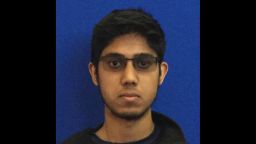Story highlights
What at first looked like act of a disgruntled student was terror-inspired, FBI says
Faisal Mohammad stabbed four at the University of California, Merced, in November
A student at the University of California, Merced, who stabbed four people on campus in November before police killed him, attacked after viewing terrorist propaganda, the FBI said.
Police initially characterized the November 4 stabbings as the misguided acts of a disgruntled student. The FBI now says Faisal Mohammad, 18, had visited websites for ISIS and other terrorist organizations before the attack.
The agency said Thursday that Mohammad had pro-ISIS propaganda on his laptop and the image of an ISIS flag in his backpack. Investigators said “he may have self-radicalized and drawn inspiration from terrorist propaganda.”
The determination brings to five the number of attacks in the United States inspired by ISIS.
ISIS has carried out or inspired more than 70 attacks in 20 countries
“Every indication is that Mohammad acted on his own; however, it may never be possible to definitively determine why he chose to attack people on the UC Merced campus,” the FBI said.
Investigators found no evidence Mohammad had worked with anyone or had ties to any foreign terrorist organizations, the FBI said.
No one died in the attack, which happened about 130 miles southeast of San Francisco.
According to authorities, Mohammad carried a hunting knife with an 8- to 10-inch blade into a room where a class he was enrolled was assembling and stabbed one of the students.
He also attacked a contract employee of the school who happened on the scene and then two others – a staff member and a student – as he left the classroom and moved across campus.

A campus police officer shot him to death, authorities said.
At the time, Merced County Sheriff Vern Warnke said it appeared that Mohammad had carried out the attack as retribution for being kicked out of a study group. Nothing suggested terror, he said at the time.
On Thursday, though, the FBI said that among the myriad items found in his backpack – zip ties, glass breaker and a knife – they located a photocopy of an ISIS flag.
Investigators also found “a two-page, hand-written plan detailing his intentions to include taking hostages and killing students and police officers,” the FBI said.
Including Mohammad’s case, there have been five ISIS-inspired attacks in the United States since October 2014. Two attacks in Canada also are believed to have been inspired by ISIS.
In the fall of 2014, authorities said U.S. citizen Zale Thompson attacked four police officers with a hatchet in New York. He was believed to have been self-radicalized. The attack left two police officers wounded, and a civilian was accidentally wounded by bullets fired by officers who killed Thompson.
Seven months later, in May 2015, gunmen said to be inspired by ISIS opened fire in Garland, Texas, outside a cartoon contest featuring images of the Prophet Mohammed. The gunmen, Elton Simpson and Nadir Soofi, wounded a security guard before police shot and killed them.
On Thursday, a federal jury in Arizona convicted ISIS supporter Abdul Malik Abdul Kareem for helping train and equip the gunmen for their attack.
On December 2, Tashfeen Malik and Syed Rizwan Farook killed 14 people and injured 21 others at a gathering of government workers in San Bernardino, California.
Malik had posted a pledge of allegiance to ISIS leader Abu Bakr al-Baghdadi on Facebook, three U.S. officials familiar with the investigation told CNN.
In January, a man named Edward Archer shot and wounded Philadelphia police Officer Jesse Hartnett. After his arrest, Archer allegedly told police, “I pledge my allegiance to the Islamic State, and that’s why I did what I did.”


















